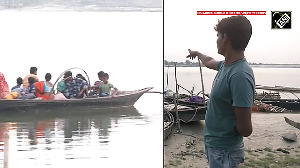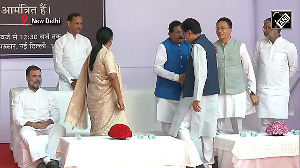Would Ukraine be such a pushover if it had that nuclear stockpile?, asks Shekhar Gupta.

Strategic studies quiz: Why was the code to inform Indira Gandhi of the successful Pokhran-1 nuclear test 'Buddha is smiling'? While you think about it, let's switch to Ukraine.
The question that has been asked often in the past few days and will continue to echo for decades to come, is: Would it have been so simple for Putin's Russia to attack Zelenskyy's Ukraine if it hadn't given up its nuclear stockpile after the Budapest accord in 1994?
This was done in return for security guarantees by the US, Europe, and Russia.
One of the guarantors has now invaded Ukraine; one, Europe, is looking for a place to hide and ruing its possible loss of cheap gas; and the third, the US, is doing no more than pour tender love and care.
Would Ukraine be such a pushover if it had that stockpile?
Now, let's turn this question inwards at ourselves.
Was India prescient or imprudent to not only build nuclear weapons but to declare itself a nuclear-armed State? Over the decades, this has seen a robust debate among four schools.
One, the Homi Bhabha-era hawks who believe India should have built its nukes in the early sixties, even pre-empting China.
Former foreign secretary Maharajakrishna Rasgotra had even stated in public interviews and seminars that President John F Kennedy had offered to help India develop and detonate a device, but that Jawaharlal Nehru turned him down.
The second school is the opposite: Nuclear weapons are ugly, immoral, unusable, unnecessary and an affront to humanity.
That school has faded lately, especially after Pokhran-2 in 1998.
Some of it has morphed into a new thought process: Now that nuclearisation is a done deal, let's work to keep it to minimum deterrence and be active and willing members of all global arrangements, including Comprehensive Test Ban Treaty (CTBT) of sorts.
The third believes that India was better served by nuclear ambiguity.
That Indira Gandhi had already shown the world our capability in 1974 with Pokhran-1.
The 1998 tests were unnecessary political chest-thumping that gave Pakistan the opportunity to test as well.
As a result, South Asia had two self-declared nuclear weapon States.
The fourth is the team that won. That mere demonstration of capability in 1974 was not enough. It was self-inflicted double defeat.
India exposed itself to sanctions, yet did not assert itself as a weapons power.
To call this Peaceful Nuclear Explosion (PNE) was pure hypocrisy that impressed none.
Not even India's public opinion at a juncture when Mrs Gandhi needed desperately to shore it up.
It was essential to weaponise, thump our chests, and throw the gauntlet at Pakistan.
The first school did not find much purchase in the fraught 1960s, and the second was rendered irrelevant after 1998.
The third and fourth need to be debated, particularly with the Ukraine staring us in the face.
Similar questions were also raised when the US invaded Iraq twice, the second time on the pretext that it had nukes.
Would Bush senior or junior have risked invading Iraq if it actually had any weapons of mass destruction (WMDs)?
Never mind that it wouldn't have the wherewithal to send them to Washington.
But just the threat of a nuclear reprisal for the invasion against any of the US's West Asian allies would have done.
Ukraine now has become an enduring advertisement for the WMD-sovereignty link.
It is making many nations comfortable today in the aura of guarantees uncomfortable.
Surely, no country with the nukes now, or one that's nearly there -- North Korea, Israel, Iran, or any other -- will ever give these up. They will remember Ukraine.
Did India gain or lose from opening its nuclear cupboard and exposing its wares to the world? The criticism is that it enabled Pakistan to find formal parity.
The answer is, nobody had any doubt that Pakistan was already a nuclear weapons State.
The Americans had given their last certificate of what was often called 'nuclear virginity' to Pakistan in 1989, and refused to renew it.
In the 1990-1991 stand-off, Pakistan had also employed the nuclear blackmail against India.
It is something books have been written about (Bob Winderm and William Burrows, Critical Mass: The Dangerous Race for Super Weapons in a Fragmenting World), then CIA deputy chief Robert Gates has spoken about it, and investigative journalist Seymour Hersh too has written a detailed piece.
I too have explained it in several of my writings since.
But, the Pakistani threat, which Robert Gates also brought to India from Islamabad on his conflict resolution visit, was that they will use the nukes in the beginning of the war.
The reality dawned on V P Singh's government that India did not have an immediately deliverable weapon in retaliation.
Over the decades, proven capability had not been developed into a credible weapons and delivery systems.
That crisis passed, but this had ended any doubts across our political spectrum, with all its divisions, that India needed the weapons fast.
March 18, 1989, is a significant day in Indian strategic evolution.
Intelligence reports were now confirming that Pakistan was indeed a screwdriver's turn away from a deliverable bomb.
On this day, the IAF was holding it customary firepower demonstration, this one involving 129 aircraft at Tilpat, a firing range not far from Delhi.
At the demonstration, Rajiv Gandhi gestured to top civil servant Naresh Chandra to follow him into a tent.
He was so secretive he even shook off a curious Rajesh Pilot, then a minister.
There he told Chandra of his concern and assigned him to head an elite group, mostly of scientists, to take India to full weaponisation. I wrote about it in some detail in 2006.
The group included top nuclear scientists R Chidambaram, P K Iyengar, Anil Kakodkar, K 'Santy' Santhanam, missile specialist A P J Abdul Kalam, and then DRDO chief V S Arunachalam.
They were to be funded mostly covertly out of a fund for 'science and technology' under the Planning Commission.
A lot of the operations were undercover and covert.
Santhanam, for example, was given a discrete senior posting in R&AW.
Dr Kakodkar later disclosed to me in a Walk the Talk on NDTV that he had to even travel overseas under assumed names and passports.
That baton passed brilliantly between seven prime ministers across a decade of political instability.
And in 1998, Pokhran-2 happened, followed by Pakistan's tit-for-tat in Chagai.
Two decades after that, where did the two new nuclear powers stand? India mostly accepted as a legitimate nuclear weapons power, admitted to most multilateral arrangements, rid of all the sanctions, and an American strategic ally.
And Pakistan? It wasn't such a bad idea to open the cupboard then.
Finally, here's why they said the Buddha was smiling for Pokhran-1.
It seems that sometime in the epoch of the Buddha, the ancient kingdom of Magadh launched a war of conquest over its neighbour Vaishali.
While Magadh was the usual monarchy that built a big army and collected the weapons for the assault, Vaishali was some kind of an anarchic street democracy where people spent all their time arguing over whether to fight, how to fight, and who will fight.
Sure enough, Magadh annihilated and massacred poorly armed Vaishali.
When the news got to a meditating Buddha, it seems, he frowned in disapproval.
Meaning that to keep the peace, a kingdom has to be fully prepared for war, or it will meet Vaishali's fate.
Since 1964, India was the Vaishali to China's Magadh.
Now you know why the Buddha would now be smiling? Or why he would be frowning at Ukraine's fate?
Feature Presentation: Aslam Hunani/Rediff.com












 © 2025
© 2025